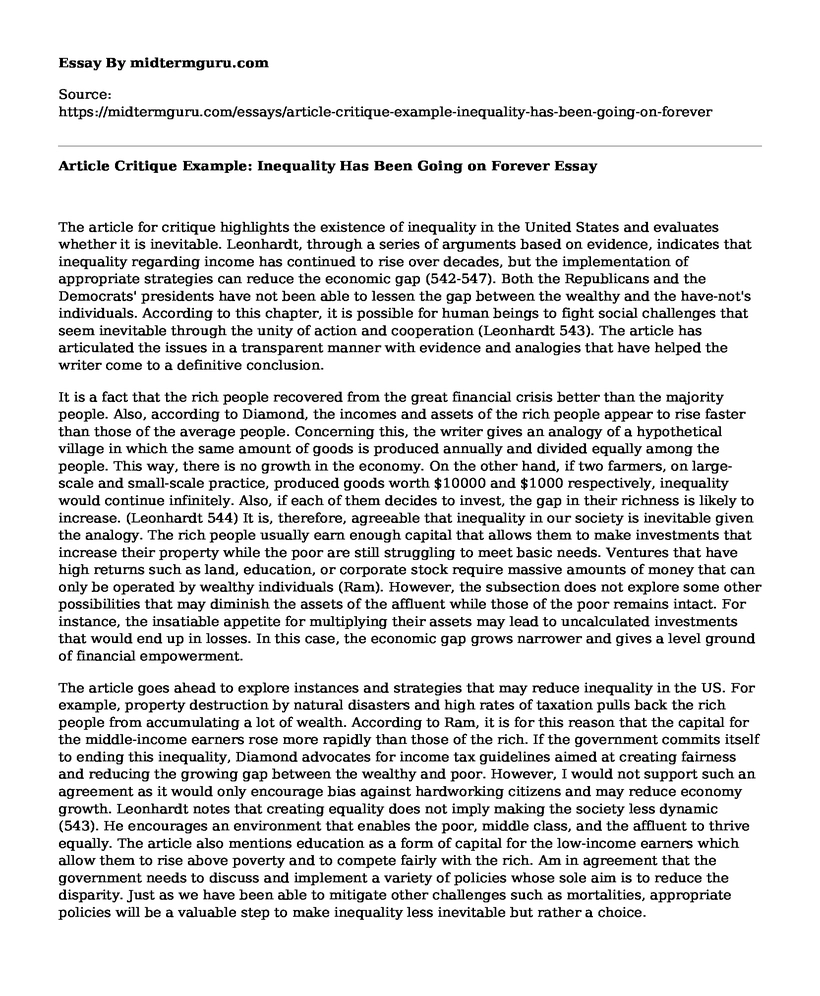The article for critique highlights the existence of inequality in the United States and evaluates whether it is inevitable. Leonhardt, through a series of arguments based on evidence, indicates that inequality regarding income has continued to rise over decades, but the implementation of appropriate strategies can reduce the economic gap (542-547). Both the Republicans and the Democrats' presidents have not been able to lessen the gap between the wealthy and the have-not's individuals. According to this chapter, it is possible for human beings to fight social challenges that seem inevitable through the unity of action and cooperation (Leonhardt 543). The article has articulated the issues in a transparent manner with evidence and analogies that have helped the writer come to a definitive conclusion.
It is a fact that the rich people recovered from the great financial crisis better than the majority people. Also, according to Diamond, the incomes and assets of the rich people appear to rise faster than those of the average people. Concerning this, the writer gives an analogy of a hypothetical village in which the same amount of goods is produced annually and divided equally among the people. This way, there is no growth in the economy. On the other hand, if two farmers, on large-scale and small-scale practice, produced goods worth $10000 and $1000 respectively, inequality would continue infinitely. Also, if each of them decides to invest, the gap in their richness is likely to increase. (Leonhardt 544) It is, therefore, agreeable that inequality in our society is inevitable given the analogy. The rich people usually earn enough capital that allows them to make investments that increase their property while the poor are still struggling to meet basic needs. Ventures that have high returns such as land, education, or corporate stock require massive amounts of money that can only be operated by wealthy individuals (Ram). However, the subsection does not explore some other possibilities that may diminish the assets of the affluent while those of the poor remains intact. For instance, the insatiable appetite for multiplying their assets may lead to uncalculated investments that would end up in losses. In this case, the economic gap grows narrower and gives a level ground of financial empowerment.
The article goes ahead to explore instances and strategies that may reduce inequality in the US. For example, property destruction by natural disasters and high rates of taxation pulls back the rich people from accumulating a lot of wealth. According to Ram, it is for this reason that the capital for the middle-income earners rose more rapidly than those of the rich. If the government commits itself to ending this inequality, Diamond advocates for income tax guidelines aimed at creating fairness and reducing the growing gap between the wealthy and poor. However, I would not support such an agreement as it would only encourage bias against hardworking citizens and may reduce economy growth. Leonhardt notes that creating equality does not imply making the society less dynamic (543). He encourages an environment that enables the poor, middle class, and the affluent to thrive equally. The article also mentions education as a form of capital for the low-income earners which allow them to rise above poverty and to compete fairly with the rich. Am in agreement that the government needs to discuss and implement a variety of policies whose sole aim is to reduce the disparity. Just as we have been able to mitigate other challenges such as mortalities, appropriate policies will be a valuable step to make inequality less inevitable but rather a choice.
Works Cited
Leonhardt, David. Inequality Has Been Going on Foreverbut That Doesnt Mean Its Inevitable. They Say I Say with Readings. Eds. Gerald Graff, Cathy Birkenstein, and Russel Durst. New York: W.W. Norton & Company, Inc., 2015. 542-547. Print.
Diamond, Peter A. "Addressing the Forces Driving Inequality in the United States." Contemporary Economic Policy, vol 34, no. 3, 2016, pp. 403-411. Wiley-Blackwell, doi:10.1111/coep.12184.
Ram, Rati. Social Capital and Income Inequality in the United States." Atlantic Economic Journal, vol 41, no. 1, 2012, pp. 89-91. Springer Nature, doi:10.1007/s11293-012-9342-2
Cite this page
Article Critique Example: Inequality Has Been Going on Forever. (2021, May 27). Retrieved from https://midtermguru.com/essays/article-critique-example-inequality-has-been-going-on-forever
If you are the original author of this essay and no longer wish to have it published on the midtermguru.com website, please click below to request its removal:
- Essay on the Recent Welfare Reform Research Findings by Fremstad
- Banker to the Poor by Muhammad Yunus Review
- Paper Example on Homophobia and Construction of Gender Inequality Through the Media
- Paper Example on Change in Women Roles and Notions of Divorce From the 1950S to the Present
- Combatting Terrorism: DHS, Firefighters, Nurses Team Up to Protect Mall - Essay Sample
- Immigration: Shaping America's History and Divisive Politics - Essay Sample
- Uniting and Strengthening America: The USA PATRIOT Act - Essay Sample







